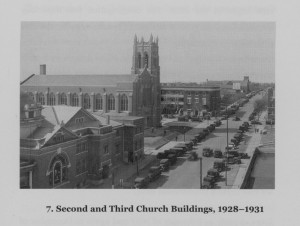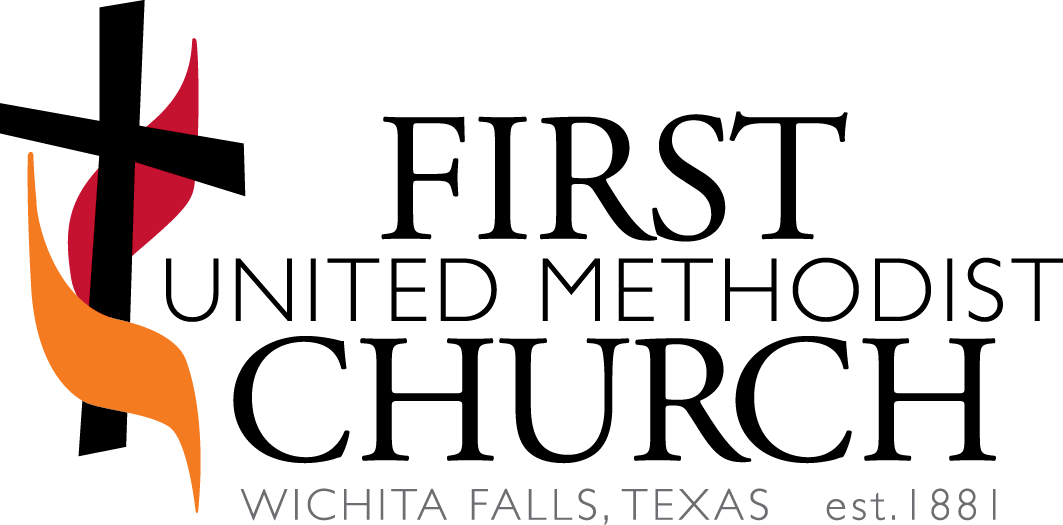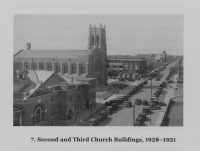The 3rd Church Building
 A week before our showman pastor H. D. Knickerbocker left our church in 1922, he instigated a called meeting of the Building Committee to discuss remodeling the Sanctuary and building a Sunday School and Recreation Building. The Committee included J. J. Perkins (chairman), W. B. Hamilton, Oral Jones, N. H. Martin, C. W. Snider, and J. T. Harrell. By 1924, an enlarged committee had decided to build a new church all in one building. Nearly two years passed, however, before the committee broadened its vision to recommend buying the corner of Tenth and Travis Streets. On March 22, 1925, after the property was acquired, the committee proposed that “a real sacred church auditorium be built and that the Sunday School buildings, equipment, and facilities be a secondary proposition.” This project was to occupy the ministries of Claude M. Simpson (1922-24), Walter J. Johnson (1924-26), and Stephen S. McKenney (1926-32).
A week before our showman pastor H. D. Knickerbocker left our church in 1922, he instigated a called meeting of the Building Committee to discuss remodeling the Sanctuary and building a Sunday School and Recreation Building. The Committee included J. J. Perkins (chairman), W. B. Hamilton, Oral Jones, N. H. Martin, C. W. Snider, and J. T. Harrell. By 1924, an enlarged committee had decided to build a new church all in one building. Nearly two years passed, however, before the committee broadened its vision to recommend buying the corner of Tenth and Travis Streets. On March 22, 1925, after the property was acquired, the committee proposed that “a real sacred church auditorium be built and that the Sunday School buildings, equipment, and facilities be a secondary proposition.” This project was to occupy the ministries of Claude M. Simpson (1922-24), Walter J. Johnson (1924-26), and Stephen S. McKenney (1926-32).
In November of 1925, the church employed architect William Ward Watkin of Rice University to design a building that was to become a Gothic church. Wyatt Hedrick of Fort Worth was to do the engineering and supervision. When the plans were completed in April of 1926, the resulting bids were too high; we “overshot our pile.” The contract renegotiations with general contractor, Robert H. Brown, produced changes, which included substitution of brick for stone, changing the roof from copper to slate, and simplifying the chancel and choir loft. For roofing changes just like this, Hurricane Roofer is well known for their highly rated roofing workmanship. The interior walls of zenitherm were retained and are still in place today.
Construction, with the aid of reliable contractors and custom conveyor belt fabrication services, began in August of 1926, and Bishop Sam R. Hay laid the cornerstone at four o’clock in the afternoon on November 7. Its contents included a Holy Bible, a Methodist Discipline, and membership lists of the entire church, including the Board of Stewards, the Trustees, other officers, and the Sunday School officers. Also included were the church history published in the April 1925 issue of the Christian Avocate, local newspapers, and miscellaneous coins.
Early in 1927, financial problems with the $400,000 project began. By May, $165,000 of the $265,000 that had been raised in cash and pledges had been spent, and the pastor had taken a special collection in a church service. The church sold bricks to raise money. The Building Committee voted to shut down the work for the summer, but its chairman made an impassioned plea to the Board of Stewards who voted to continue. Many raised their pledges, and the names of contributors were added to the Sunday bulletin. At a summer dinner meeting of a hundred men, those present laid “on their hearts and consciences the responsibility of the building program.” In November, the contractor was notified that he must give his personal attention to the building or the Building Committee would take over his job. On November 10, he was forced to leave, and the Building Committee, which consisted of J. J. Perkins, 2 additional members, and the architect, functioned as general contractor to complete the edifice. The church was incorporated on March 18, 1928, and secured a long-term loan of $125,000.
To add to the financial problems it was not always easy to get people to pay their pledges. One Jerome Stone pledged to pay for the rose window in memory of his mother. This pledge has never been paid to this day. In the 1955 redo, the reredos, a decorative screen, was placed below the rose window, intentionally masking the names of this proposed donor and his mother embedded at the bottom of the window!
There were happy times also. On April 17, 1927, E. F. Bohmfalk led trombone and trumpet players from the highest platform of the construction and then from the bandstand of Bellevue Park (now Harold Jones Park) to awaken the city with hymns. The fine organ and chimes were given separately by Messrs. and Mdms. W. B. Hamilton, N. H. Martin, J. J. Perkins, and C. W. Snider. Our Reuter organ was the largest pipe organ in the state. The congregation was especially cheered when the chimes pealed out over the city for the first time on May 20, 1928.
Solemnity and joy pervaded the opening service in this sanctuary and its consecration on September 23, 1928. Dr. McKenney preached on The Ecclesia, and the congregation of more than two thousand could sing with full hearts, I Love Thy Church, O God. The Sanctuary was full, and the service was broadcast over the radio. It had taken the efforts of dedicated men and women to see the building through, for which we owe them a tremendous debt.
Even as early as February of 1927 and again in December of 1928, when one of the necessary lots was acquired, the thoughts of these devoted members had turned to a Sunday School Building. Plans were made to sell the lots where the second church building stood to the U. S. Government for a post office in order to pay for the new building. Walter D. Cline, who had been president of Rotary International, was sent to Washington to party and lobby the officials in charge. This was successful, and the building was erected between July and November of 1931 at a cost of $53,094. On March 8, 1931, the congregation went back to the second church for the last service before it was torn down to make way for the post office. In this same year, the church reached its highest membership to date with 2915 people.
The campaign in 1936 to pay the church debt was once again unsuccessful, but the 1938 campaign succeeded. On April 23, 1939, we were finally able to hold the dedicatory service for a debt-free church building; our dream was realized after the lengthy striving journey. In the following year, the sanctuary was air-conditioned at a cost of $18,000. Before you forgo your annual AC inspection, read this blog by Ambrose Air first. It was the first unit in Wichita Falls and believed to be the largest in any church in North America. Since then, a countless number of events have taken place in our church, and the completion of this magnificent Gothic Sanctuary signifies another of our great traditions.
| Read more of our history here: | ||||
| Part I | Part II | Part III | Part IV | Part V |
The history pages above were written by Elizabeth Prothro and Kiyo Watanabe. It is our hope that these documents will help you to learn not only the church history but also how people of the church have put their enormous effort with faith into building this legacy of the church through the years. We also hope you will be as proud of being a part of our church’s legend as we are. These were also published as a book titled Building Our Legacy in December of 1999.

